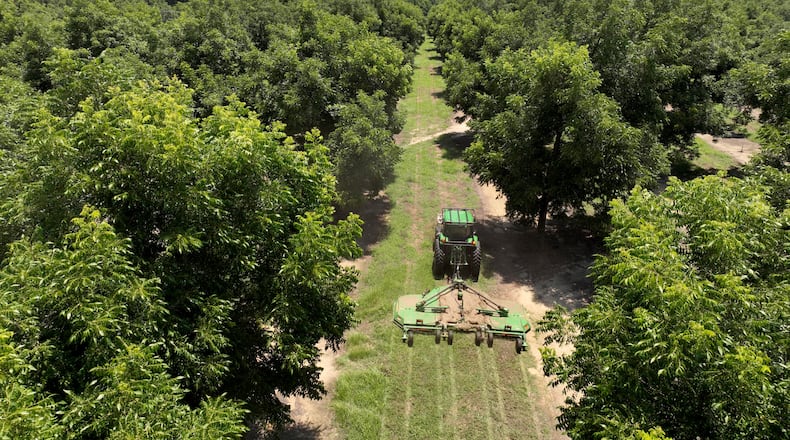Despite harvesting a good crop, Tift County’s Lewis Taylor Farms was not profitable last year. The large vegetable operation lost $1.5 million.
It likely will be even more in the red at the end of 2023, said the farm’s president, Bill Brim. The reason? Payroll costs have surged by $2.5 million, he said.
Last January, the federal government implemented a wage hike for foreign, seasonal farmworkers in Georgia, upping their minimum pay from $11.99 to $13.67 an hour. According to agriculture industry groups in the state, that increase has amounted to a devastating business challenge for scores of Georgia growers, who rely on a temporary agricultural visa program, known as H-2A, to keep their farms staffed and operating. For much of the past decade, Georgia has been among the country’s top users of H-2A migrant guestworkers.
“We are just not able to survive with this kind of increase,” Brim, who employs roughly 500 H-2A workers, said via text.
Wages paid under the H-2A program grew nationwide this year The federal government sets different minimum wages for different states. Georgia’s 14% wage hike was surpassed only by one other state — Florida, where H-2A wages grew by 15% to $14.33 an hour.
At $13.67, hourly wages for Georgia migrant farmworkers remain the lowest in the nation, a rate shared by four other states in the South: Alabama, Arkansas, Louisiana and South Carolina. Even so, the increase was a steep one for farmers operating on already thin margins.
“Our first reaction was shock,” Will Bentley, president of the Georgia Agribusiness Council, said of the moment in late 2022 when the U.S. Department of Labor unveiled the higher pay rate. “We just knew it was going to be a hardship that unfortunately not everybody was going to be able to weather. And we just knew that we’re going to have farmers that would be forced to go out of business because they simply couldn’t pay those increased wage rates.”
This year has brought additional challenges to Georgia farmers, including severe temperature swings, torrential rain and hail storms that ruined the harvest of key crops, including peaches, blueberries and cotton. Meanwhile, according to Bentley, the cost of fuel, fertilizer and other farm necessities has continued to go up.
“Our farmers were already teetering on the edge, and then our very own federal government really slapped them in the face with a huge wage increase.”
Chris Butts, executive director of the Georgia Fruit and Vegetable Growers Association, told The Atlanta Journal-Constitution that the new H-2A wage rate increased growers’ labor costs around the state by upward of $100 million in 2023.
The more generous remuneration is welcomed news for Georgia farmworkers, advocates said. But they say workers’ lives haven’t materially changed, noting that some employers find ways to avoid paying farmworkers all that they are owed. According to the Department of Labor’s Wage and Hour Division (WHD), which is responsible for enforcing the H-2A program’s rules, wage theft is among the violations most often committed by employers. After conducting roughly 650 investigations nationwide between fiscal years 2017 and 2021, WHD found more than $ 4.7 million in back wages owed to workers.
“Whether they’re making $11.99 or $13.67, there’s still a big struggle. You know, it’s not going to get them out of poverty at all,” said Alma Young, who works with H-2A workers in South Georgia through her role as coordinator with the United Farm Workers Foundation.
Some farmers hire contractors to find H-2A workers. In October, the AJC reported on claims that contractors are charging workers illegal recruitment fees, putting workers in debt even before they arrive in the U.S. and making them vulnerable to abuse.
“There are still so many things that affect how much workers really make and very few of them are actually making” the mandatory minimum wage, Young said.
Jim Knoepp is a senior supervising attorney for the Southern Poverty Law Center’s Immigrant Justice Project. He said he worries about “people not getting paid for all the hours that they worked because the employer has a certain budget that they want to keep within, and they’re like, ‘Well, you know, if I short people an hour or two every day, then even though the wage rate has gone up … I’m going to be saving.’”
‘There is no alternative’
Because the H-2A program was designed to avoid jeopardizing the employment prospects of domestic workers, hiring migrant H-2A workers is a costly proposition. Employers must provide for workers’ housing and transportation. They must also pay them well enough to not adversely affect the wages or working conditions of U.S. workers. To that end, the Department of Labor sets a minimum wage using data from federal wage surveys.
According to Dr. Cesar Escalante, a professor in the Department of Agricultural and Applied Economics at UGA’s College of Agricultural and Environmental Sciences, an increase in minimum H-2A wage was needed this year to ensure the workers were paid a “livable” wage. Still, he believes the increase should have been more modest.
Previously, it had taken seven small wage hikes from 2014 to 2022 to boost the minimum H-2A pay from $10 to $11.99.
The announcement of the new 2023 H-2A minimum wage in Georgia mobilized lawmakers. All eight Republican U.S. representatives signed a letter expressing concern over the increase. And Democratic Senator Jon Ossoff introduced a bill that sought to temporarily freeze the H-2A minimum wage to 2022 levels, citing a “sudden and massive increase in costs.”
That stance has been criticized by farmworker advocates who collaborated with Ossoff on his efforts to push for increased H-2A worker protections after investigators uncovered a case of “modern-day slavery” in which Georgia farm workers were trafficked from other countries and put to work in inhumane conditions.
“I was very upset and extremely disappointed and heartbroken because out of everybody, he should have known better. And this is something that I’ve said to him personally,” said Young with the United Farm Workers Foundation.
Ossoff’s office did not respond to the AJC’s request for comment.
Despite the wage increase, the number of certified H-2A positions actually grew in Georgia this fiscal year, from 34,974 in 2022 to 37,536 in 2023, according to federal data.
Industry groups and experts say that reflects a core truth about the labor landscape in Georgia’s agriculture industry: Farmers have no alternative labor source to H-2A foreign guestworkers, regardless of how onerous the program requirements and costs may be.
Farmers “cannot ignore the fact that they need labor, and they don’t have anywhere else to go,” Escalante said. He explained that domestic workers are both extremely scarce and less productive than H-2A workers. And because of the size and business profile of the average Georgia farm, mechanization is not a viable option.
“There is no alternative,” said Butts, with the Georgia Fruit and Vegetable Growers Association. “If you want workers, if you need workers, this (program) is about the only place you’ve got to find that source of labor. … Growers, they don’t have a choice.”
About the Author
Keep Reading
The Latest
Featured



